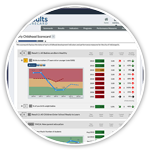Pretend, for a moment, that I can split you into two people and give you two separate teaching assignments for one year. You, Version A, are given a 3rd grade class in an upper middle class neighborhood. You, Version B, are given a 3rd grade class in a poor urban neighborhood. In both cases, your job is to teach the children in your class to read. At the end of the year, you will be evaluated on the basis of the average reading scores in your classrooms. The one with the higher score will be retained. The one with the lower score will be fired. Which of you will be fired and why?
The answer is obvious. The children in the poorer classroom started out with lower scores and finished with lower scores. You did a lousy job teaching this class. You are a bad teacher and deserve to be fired.
OK. That’s unfair. Let’s change the rules. Let’s look at the amount of improvement in reading from the beginning of the year to the end of the year. Well the one of you who taught in the poor school still gets fired because the children not only started off behind, but more of them have learning difficulties, live in homes where there are no books and have parents who can’t read.
OK. That’s not fair either. You can’t compare classes in two different schools like that. Let’s back up and give you two different classes in the same school. But you will quickly see that the same things will also happen between any two classes in the same school. Some students will do better or worse for reasons that have nothing to do with who you are or how good a teacher you are.
Fast forward to the 2012 Olympic Diving Competitions. Diver A does a triple back flip off the high dive but misses the water entry. Diver B does a swan dive off the low dive but nails the entry. How can we compare Diver A and Diver B. The Olympic Committee has an answer: “degree of difficulty.” One dive is harder than the other and is judged differently.
The same principle could be applied to teaching, but imagine how much harder it would be to assign a “degree of difficulty” to a child. Now try creating a degree of difficulty for a whole classroom. Now think about how to adjust that degree of difficulty over the year as the class changes when children move from one school to another.
There is a lot of discussion today about getting rid of “bad teachers.” You would think from hearing this that the problems in our education system are caused principally by a large number of bad teachers that the system refuses to fire. One could, of course, make a similar case that the problem with our legal system is a large number of bad lawyers that the system refuses to debar. The problem with the medical system is a large number of bad doctors that the system refuses to decertify. The point is that there is no simple way to use achievement test data to evaluate teachers, any more than there are simple ways to use patient data to evaluate doctors or law suit data to evaluate lawyers. Anyone who believes otherwise doesn’t know very much about teaching (medicine or law).
This does not mean that we can not use data to improve our education system. Using data to drive school improvement is different than using data to fire teachers. When schools make use of data to drive improvement it is usually site based (or school level) data, not individual teacher data, (e.g. total school 3rd grade reading scores). Schools have a place where trend data on achievement test scores, attendance rates, graduation rates and rates of teacher retention are prominently displayed. There is an inclusive process for interpreting this data and taking action that involves a wide range of partners, including teachers, principals, superintendents, parents, business leaders, the faith community, elected officials, the media and the students themselves.
When school improvement is managed this way it has a much greater chance for success and is far more constructive than blaming teachers or anyone else. The vast majority of teachers are dedicated hard-working professionals who often work under extremely difficult conditions. People who suggest that fixing schools equates with firing teachers do so because it is easier to name scapegoats than do the hard work of making our schools better. We will never get anywhere if we misconstrue the very nature of the problems we seek to solve.
Note: I am aware that I have touched only lightly on school improvement planning. Education is addressed in many places in “Trying Hard Is Not Good Enough,” but see in particular the section “Unified Planning for Education” on pages 118-119. I have also not endorsed any particular method for teacher evaluation (e.g. peer review). I believe that individual performance evaluation in education or any other service system is a by-product of good supervision. When I was a first year high school math teacher I received essentially no supervision or support which is one of the reasons I only lasted one year. We have generally done a poor job of training people to be supervisors in the public and non-profit sectors. Supervision and individual performance evaluation must be addressed together and are topics for future writing. See pages 81, 84 and 105 for some more thoughts on these subjects.



